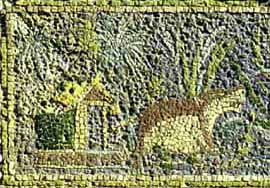|
White and Yellow Glass
Addition of an antimony-rich mineral, and an
oxidizing atmosphere in the furnace, will produce glass with a white
coloration. The reaction between the antimony and the lime from
the frit causes a precipitation of minute needles of calcium antimonate.
As the antimony increases from 1% to 10%, the white coloration changes
from eggshell-fine to creamy-rich.
A brilliant yellow coloration is produced if
the mineral added to the glass contains both antimony and lead.
Under the right conditions, the lead and antimony precipitate out
together, creating needles of lead pyroantimonate. The Romans rarely used
yellow glass on its own: instead they included it in polychrome
mosaic wares and architectural friezes.
|
|
Detail of mosaic glass

Glass and shell mosaic from the
courtyard of the Casa del Granduca at Pompeii
First half of 1st century A.D.
|

